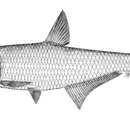Comprehensive Description
provided by Smithsonian Contributions to Zoology
Thryssa rastrosa
USNM 217038, Holotype, Fly 75–5, 108.7 mm.
USNM 217039, Paratype, Fly 75–6, 116.2 mm.
USNM 217040, Paratypes, Fly 75–22, 14: 33.0–48.7 mm.
USNM 217041, Paratype, Fly 75–24, 73.0 mm.
USNM 217042, Paratypes, Fly 75–25, 80: 29.2–80.6 mm (4 to BMNH).
This zooplanktophagous species, inhabiting the mainstream and tributaries of the Upper and Middle Fly, is notable for its exceptionally numerous gill rakers, which apparently increase in number as long as growth continues. Four paratypes have the following numbers of gill rakers on the anterior face of the first gill arch: 33.0 mm, 27+41; 48.7 mm, 35+51; 73.0 mm, 43+61; 116.2 mm, 59+78. (No previously described Thryssa, and no engraulid species from the Indian Ocean or tropical Western Pacific, is known with more than 30 gill rakers on the lower limb of the first gill arch.) Lower jaw not extending so far anteriorly as in T. scratchleyi. Maxillary bone not extending posteriorly beyond opercle. Eye diameter 12.9–14.5. Gill rakers absent on posterior face of third gill arch. Total anal fin rays 33–36. Scales in lateral series 40–41. Abdominal scutes 16–19+10–11. Tips of pelvic fins extending posteriorly beyond a vertical through origin of dorsal fin. Complete vertebrae 43–44. Caudal peduncle length 9.4–11.8. No humeral or nuchal pigment blotch.
- bibliographic citation
- Roberts, Tyson R. 1978. "An ichthyological survey of the Fly River in Papua New Guinea with descriptions of new species." Smithsonian Contributions to Zoology. 1-72. https://doi.org/10.5479/si.00810282.281

